Ryobi RY34000 User Manual
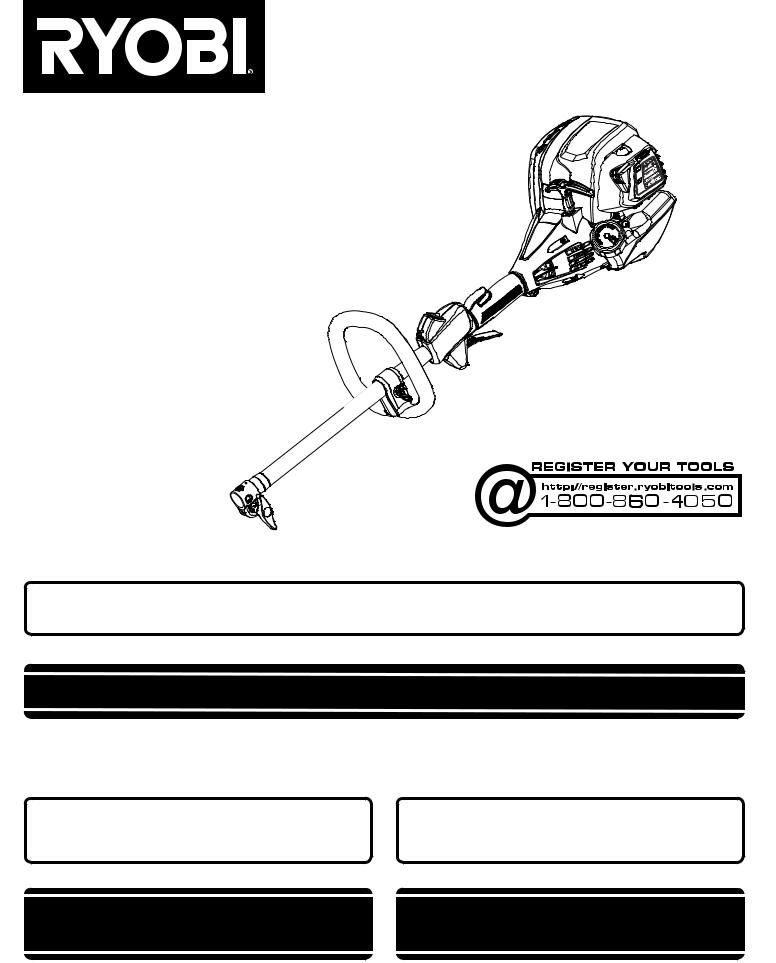
OPERATOR’S MANUAL
MANUEL D’UTILISATION
MANUAL DEL OPERADOR
30cc 4-CYCLE POWER HEAD
BLOC-MOTEUR 4-TEMPS DE 30 cc
CABEZAL MOTOR DE CUATRO TIEMPOS 30 cc
RY34000
ALL VERSIONS
TOUTES LES VERSIONS
TODAS LAS VERSIONES
Your power head has been engineered and manufactured to our high standard for dependability, ease of operation, and operator safety. When properly cared for, it will give you years of rugged, trouble-free performance.
 WARNING: To reduce the risk of injury, the user must read and understand the operator’s manual before using this product.
WARNING: To reduce the risk of injury, the user must read and understand the operator’s manual before using this product.
Thank you for your purchase.
SAVE THIS MANUAL FOR FUTURE REFERENCE
Ce bloc-moteur a été conçu et fabriqué conformément à nos strictes normes de fiabilité, simplicité d’emploi et sécurité d’utilisation. Correctement entretenu, cet outil vous donnera des années de fonctionnement robuste et sans problème.
 AVERTISSEMENT : Pour réduire les risques de blessures, l’utilisateur doit lire et veiller à bien comprendre le manuel d’utilisation avant d’employer ce produit.
AVERTISSEMENT : Pour réduire les risques de blessures, l’utilisateur doit lire et veiller à bien comprendre le manuel d’utilisation avant d’employer ce produit.
Merci de votre achat.
Su cabezal motor ha sido diseñado y fabricado de conformidad con nuestras estrictas normas para brindar fiabilidad, facilidad de uso y seguridad para el operador. Con el debido cuidado, le brindará muchos años de sólido funcionamiento y sin problemas.
 ADVERTENCIA: Para reducir el riesgo de lesiones, el usuario debe leer y comprender el manual del operador antes de usar este producto.
ADVERTENCIA: Para reducir el riesgo de lesiones, el usuario debe leer y comprender el manual del operador antes de usar este producto.
Le agradecemos su compra.
CONSERVER CE MANUEL POUR |
GUARDE ESTE MANUAL PARA |
FUTURE RÉFÉRENCE |
FUTURAS CONSULTAS |
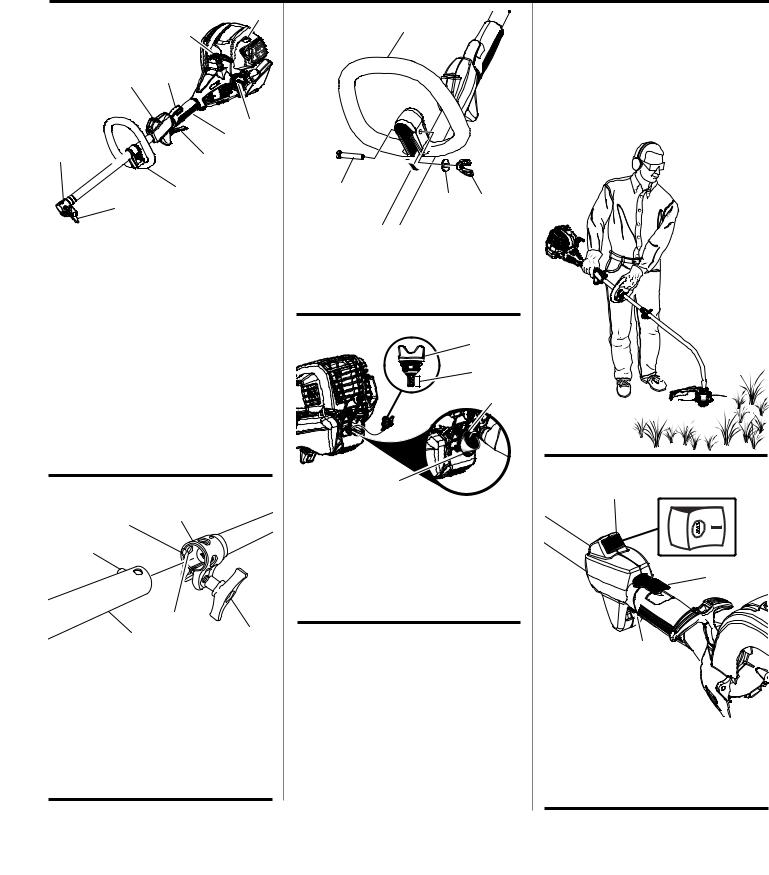
See this fold-out section for all the figures referenced in the operator’s manual.
Voir que cette section d’encart pour toutes les figures a adressé dans le manuel d’utilisation.
Vea esta sección de la página desplegable para todas las figuras mencionó en el manual del operador.
Fig. 1 |
|
E |
|
D |
|
B |
C |
|
|
G |
F |
A |
|
|
H |
|
|
|
|
|
|
I |
|
J |
|
|
A - Coupler (coupleur, acoplador)
B - Stop switch (commutateur d’arrêt, interruptor de apagado)
C - Trigger lock out (gâchette avec verrou, gatillo con seguro)
D - Starter grip and rope (poignée du lanceur et corde, mango del arrancador y cuerda)
E - Primer bulb (poire d’amorçage, bomba de cebado)
F - Fuel cap (bouchon de carburant, tapa del tanque)
G - Rear handle (poignée arrière, mango trasero) H - Throttle trigger (gâchette d’accélérateur,
gatillo del acelerador)
I - Front handle (poignée avant, mango delantero)
J - Knob (bouton, perilla)
Fig. 2
B C D
A
F
G E
A - Button (bouton, botón)
B - Guide recess (logement guide, hueco guía) C - Coupler (coupleur, acoplador)
D - Power head shaft (arbre du bloc moteur, eje del cabezal motor)
E - Knob (bouton, perilla)
F - Positioning hole (trou de positionnement, orificio de posicionamiento)
G - Attachment shaft (arbre d’accessoire, eje del aditamento)
Fig. 3
B
A
C D
A - Bolt (boulon, perno)
B - Front handle (poignée avant, mango delantero)
C - Washer (rondelle, arandela)
D - Wing nut (écrou papillon, tuerca de mariposa)
Fig. 4
A
B
C
D
A - Oil cap/dipstick (bouchon/jauge d’huile, tapa de relleno de aceite / varilla medidora de aceite)
B - Hatched area (zone hachurée, área cubierta con rayas entrecruzadas)
C - Funnel (entonnoir, embudo)
D - Oil fill hole (orifice de remplissage d’huile, agujero de llenado de aceite)
Fig. 5
PROPER TRIMMER ATTACHMENT
OPERATING POSITION
ACCESSOIRE TAILLE-BORDURE
POSITION DE TRAVAIL
POSICIÓN CORRECTA PARA EL MANEJO DE ADITAMENTO PARA RECORTAR
Fig. 6
A
B
C
A - Stop switch (commutateur d’arrêt, interruptor de apagado)
B - Trigger lock out (gâchette avec verrou, gatillo con seguro)
C - Throttle trigger (gâchette d’accélérateur, gatillo del acelerador)
ii
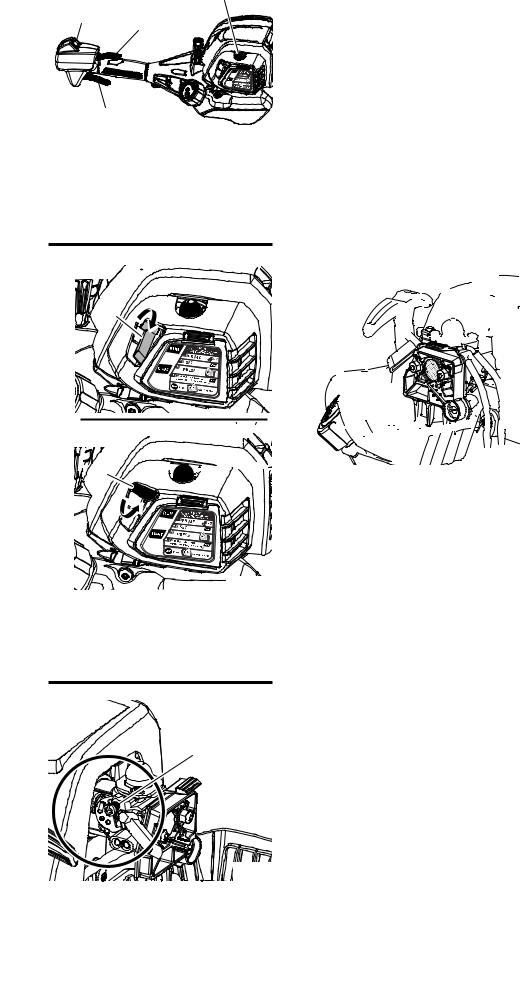
Fig. 7 |
C |
A |
B |
|
D
A - Stop switch (commutateur d’arrêt, interruptor de apagado)
B - Trigger lock out (gâchette avec verrou, gatillo con seguro)
C - Primer bulb (poire d’amorçage, bomba de cebado)
D - Throttle trigger (gâchette d’accélérateur, gatillo del acelerador)
Fig.
 8
8



 A
A
B


 C
C 








 B
B 






A - Start position (position de démarrage , posición de arranque)
B - Start lever (palanca de arranque, levier de volet de départ)
C - Run position (position de marche , posición de marcha)
Fig. 9
A
A - Idle 
 speed screw (vis de ralenti, tornillo de ajuste de la velocidad en vacío)
speed screw (vis de ralenti, tornillo de ajuste de la velocidad en vacío)
Fig. 10
A
B
C
A - Latch (loquet, pestillo)
B - Air filter cover (couvercle du filtre à air, tapa del filtro de aire)
C - Pull cover to open (tirer sur le couvercle pour l’ouvrir, tire de la tapa para abrirla)
Fig. 11 |
B |
C |
|
||
A |
|
|
A - Air filter cover (couvercle du filtre à air, tapa del filtro de aire)
B - Filter screen (filtre écran, filtro pantalla) C - Latch (loquet, pestillo)
Fig. 12
B
A
C
A - Screw (vis, tornillo) |
A |
|
B - Top engine cover (couvercle moteur supérieur, cubierta superior del motor)
C - Bottom cover (couvercle inférieure, cubierta inferior)
Fig. 13
A
B
A - Starter grip and rope (poignée du lanceur et corde, mango del arrancador y cuerda)
B - Deep hole in camshaft gear (trou profond situé dans l’engrenage de l’arbre à cames, orificio profundo en el engranaje del árbol de levas)
Fig. 14 |
C |
D |
|
||
B |
|
|
A
A - Feeler gauge (jauge d’épaisseur, calibrador de separaciones)
B - Rocker arm (culbuteur, balancín)
C - Rocker arm cover (cache-culasse, tapa del balancín)
D - Screw (vis, tornillo)
Fig. 15 |
C |
|
|
|
A |
B
A - Retaining nut (écrou de retenue, tuerca de retencion)
B - Adjusting nut (écrou de réglage, tuerca de ajuste)
C - Stud (goujon, elemento estructural)
iii

TABLE OF CONTENTS
TABLE DES MATIÈRES / ÍNDICE DE CONTENIDO
Introduction....................................................................................................................................................................... |
2 |
Introduction / Introducción |
|
General Safety Rules...................................................................................................................................................... |
3-4 |
Règles de sécurité générales / Reglas de seguridad generales |
|
Specific Safety Rules........................................................................................................................................................ |
4 |
Règles de sécurité particulières / Reglas de seguridad específicas |
|
Symbols............................................................................................................................................................................ |
5 |
Symboles / Símbolos |
|
Features............................................................................................................................................................................ |
6 |
Caractéristiques / Características |
|
Assembly........................................................................................................................................................................ |
6-7 |
Assemblage / Armado |
|
Operation....................................................................................................................................................................... |
7-8 |
Utilisation / Funcionamiento |
|
Maintenance................................................................................................................................................................. |
9-10 |
Entretien / Mantenimiento |
|
Troubleshooting............................................................................................................................................................... |
11 |
Dépannage / Solución de problemas |
|
Warranty..................................................................................................................................................................... |
12-14 |
Garantie / Garantía |
|
Parts Ordering and Service................................................................................................................................ |
Back Page |
Commande de pièces et réparation / Pedidos de piezas y servicio.......................................................... |
Page arrière / Pág. posterior |
INTRODUCTION
INTRODUCTION / INTRODUCCIÓN
This product has many features for making its use more pleasant and enjoyable. Safety, performance, and dependability have been given top priority in the design of this product making it easy to maintain and operate.
* * *
Ce produit offre de nombreuses fonctions destinées à rendre son utilisation plus plaisante et satisfaisante. Lors de la conception de ce produit, l’accent a été mis sur la sécurité, les performances et la fiabilité, afin d’en faire un outil facile à utiliser et à entretenir.
* * *
Este producto ofrece numerosas características para hacer más agradable y placentero su uso. En el diseño de este producto se ha conferido prioridad a la seguridad, el desempeño y la fiabilidad, por lo cual se facilita su manejo y mantenimiento.
2

GENERAL SAFETY RULES
 WARNING:
WARNING:
Read and understand all instructions. Failure to follow all instructions may result in electric shock, fire and/or serious personal injury.
READ ALL INSTRUCTIONS
For safe operation, read and understand all instructions before using this product. Follow all safety instructions. Failure to follow all safety instructions, can result in serious personal injury.
Do not allow children or untrained individuals to use this unit.
Never start or run the engine in a closed or poorly ventilated area; breathing exhaust fumes can kill.
Clear the work area before each use. Remove all objects such as rocks, broken glass, nails, wire, or loose string which can be thrown or become entangled in the cutting line or blade.
Always wear eye protection with side shields marked to comply with ANSI Z87.1. Failure to do so could result in objects being thrown into your eyes, resulting in possible serious injury.
Wear heavy, long pants, long sleeves, boots, and gloves. Do not wear loose fitting clothing, short pants, sandals, or go barefoot. Do not wear jewelry of any kind.
Heavy protective clothing may increase operator fatigue, which could lead to heat stroke. During weather that is hot and humid, heavy work should be scheduled for early morning or late afternoon hours when temperatures are cooler.
Product users on United States Forest Service land, and in some states, must comply with fire prevention regulations. This product is equipped with a spark arrestor; however, other user requirements may apply. Check with your federal, state, or local authorities.
Never operate this unit on the operator’s left side.
Secure long hair above shoulder level to prevent entanglement in moving parts.
Keep all bystanders, children, and pets at least 50 ft. away. Bystanders should be encouraged to wear eye protection. If you are approached, stop the engine and cutting attachment. In the case of bladed units, there is the added risk of injury to bystanders from being struck with the moving blade in the event of a blade thrust or other unexpected reaction of the blade or saw chain.
Do not operate this unit when you are tired, ill, or under the influence of alcohol, drugs, or medication.
Do not operate in poor lighting.
Keep firm footing and balance. Do not overreach. Overreaching can result in loss of balance or exposure to hot surfaces.
Do not use on a ladder or unstable support. Stable footing on a solid surface enables better control of the unit in unexpected situations.
Keep all parts of your body away from any moving part.
To avoid hot surfaces, never operate the unit with the bottom of the engine above waist level.
Do not touch area around the muffler or cylinder of the unit, these parts get hot from operation.
Always stop the engine and remove the spark plug wire before making any adjustments or repairs except for carburetor adjustments.
Inspect the unit before each use for loose fasteners, fuel leaks, etc. Replace any damaged parts before use.
The cutting attachment should never rotate at idle during normal use. The cutting attachment may rotate at idle during carburetor adjustments.
It has been reported that vibrations from hand-held tools may contribute to a condition called Raynaud’s Syndrome in certain individuals. Symptoms may include tingling, numbness, and blanching of the fingers, usually apparent upon exposure to cold. Hereditary factors, exposure to cold and dampness, diet, smoking, and work practices are all thought to contribute to the development of these symptoms. It is presently unknown what, if any, vibrations or extent of exposure may contribute to the condition. There are measures that can be taken by the operator to possibly reduce the effects of vibration:
a)Keep your body warm in cold weather. When operating the unit wear gloves to keep hands and wrists warm. It is reported that cold weather is a major factor contributing to Raynaud’s Syndrome.
b)After each period of operation, exercise to increase blood circulation.
c)Take frequent work breaks. Limit the amount of exposure per day.
d)Keep the tool well maintained, fasteners tightened, and worn parts replaced.
If you experience any of the symptoms of this condition, immediately discontinue use and see your physician about these symptoms.
Store fuel in a container approved for gasoline.
Stop the engine and allow to cool before refueling or storing the unit.
3 — English

GENERAL SAFETY RULES
Allow the engine to cool; empty the fuel tank and secure the unit from moving before transporting in a vehicle.
Wear your protective equipment and observe all safety instructions. For units equipped with a clutch, be sure
the cutting attachment stops turning when the engine idles. When the unit is turned off make sure the cutting attachment has stopped before the unit is set down.
SPECIFIC SAFETY RULES
SPECIFIC SAFETY RULES FOR TRIMMER USE
Inspect before use. Replace damaged parts. Make sure fasteners are in place and secure. Check for fuel leaks.
Replace string head if cracked, chipped, or damaged in any way. Be sure the string head or blade is properly installed and securely fastened. Failure to do so can cause serious injury.
Make sure all guards, straps, deflectors, and handles are properly and securely attached.
Use only the manufacturer’s replacement line in the cutting head. Do not use any other cutting attachment. To install any other brand of replacement line or cutting head to this string trimmer can result in serious personal injury. Never use, for example, wire or wire-rope, which can break off and become a dangerous projectile.
Never operate unit without the grass deflector in place and in good condition.
Never use blades, flailing devices, wire, or rope on trimmer attachment.
Maintain a firm grip on both handles while trimming. Keep string head below waist level. Never cut with the string head located over 30 in. or more above the ground.
SPECIFIC SAFETY RULES FOR BRUSHCUTTER AND BLADE USE
Brushcutter blades coast after throttle trigger is released or engine is stopped. Keep the rotating blade in thicker weeds or pulpy stalks until the blade completely stops.
Do not operate the brushcutter unless the brushcutter guard is firmly secured in place and in good condition.
Use heavy gloves when operating the brushcutter and when installing or removing blades.
Always stop the engine and remove the spark plug wire before attempting to remove any obstruction caught or jammed in the blade or before removing and installing the blade.
Do not attempt to touch or stop the blade when it is rotating.
A coasting blade can cause injury while it continues to spin after the engine is stopped or throttle trigger released. Maintain proper control until the blade has completely stopped rotating.
Replace any blade that has been damaged. Always make sure blade is installed correctly and securely fastened before each use. Failure to do so can cause serious injury.
Use only the manufacturer’s replacement Tri-Arc® blade intended for use on this brushcutter. Do not use any other blade. To install any other brand blade or cutting head to this brushcutter can result in serious personal injury.
The Tri-Arc® blade is suited for cutting thicker weeds or pulpy stalks only. Do not use for any other purpose. Never use the Tri-Arc® blade to cut woody brush.
Exercise extreme caution when using the blade with this unit. Blade thrust is the reaction that may occur when the spinning blade contacts anything it cannot cut. This contact may cause the blade to stop for an instant, and suddenly “thrust” the unit away from the object that was hit. This reaction can be violent enough to cause the operator to lose control of the unit. Blade thrust can occur without warning if the blade snags, stalls, or binds. This is more likely to occur in areas where it is difficult to see the material being cut. For cutting ease and safety, approach the weeds being cut from the right to the left. In the event an unexpected object or woody stock is encountered, this could minimize the blade thrust reaction.
Never cut any material over 1/2 in. diameter.
Always wear the shoulder harness when using the brushcutterandadjusttoacomfortableoperatingposition. Maintain a firm grip on both handles while cutting with a blade. Keep the blade away from your body and below waist level.
Never use the brushcutter with the blade located 30 in. or more above the ground level.
Save these instructions. Refer to them frequently and use them to instruct others who may use this tool. If you loan someone this tool, loan them these instructions also.
NOTE: ADDITIONAL SPECIFIC SAFETY RULES CAN BE FOUND IN THE APPLICABLE ATTACHMENT’S OPERATOR’S MANUAL
4 — English
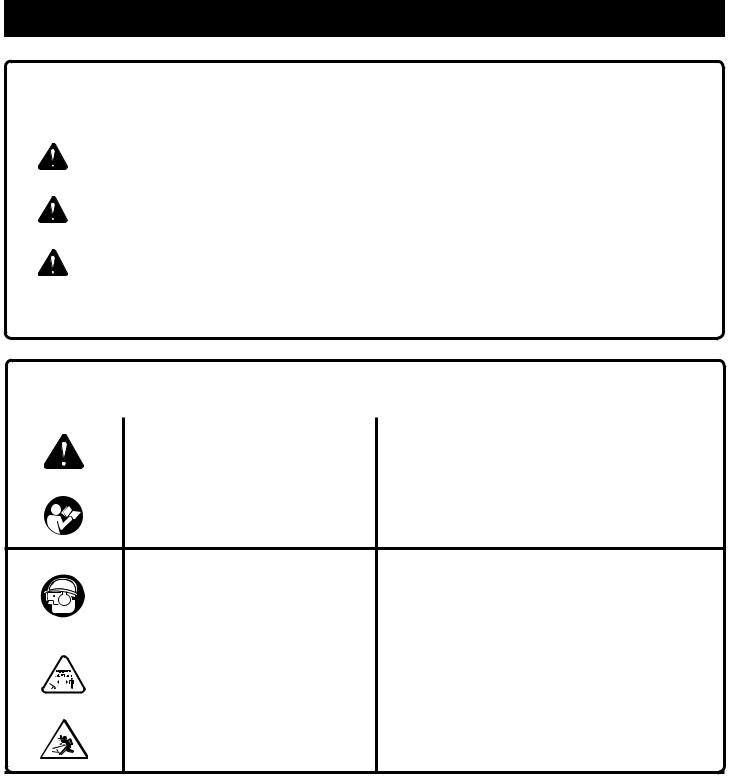
SYMBOLS
The following signal words and meanings are intended to explain the levels of risk associated with this product.
SYMBOL |
SIGNAL |
MEANING |
|
|
|
|
DANGER: |
Indicates an imminently hazardous situation, which, if not avoided, will result |
|
in death or serious injury. |
|
|
|
|
|
|
|
|
WARNING: |
Indicates a potentially hazardous situation, which, if not avoided, could result |
|
in death or serious injury. |
|
|
|
|
|
|
|
|
CAUTION: |
Indicates a potentially hazardous situation, which, if not avoided, may result in |
|
minor or moderate injury. |
|
|
|
|
|
|
|
|
CAUTION: |
(Without Safety Alert Symbol) Indicates a situation that may result in property |
|
damage. |
|
|
|
Some of the following symbols may be used on this product. Please study them and learn their meaning for safe operation of this product.
SYMBOL |
NAME |
EXPLANATION |
|
Safety Alert |
Indicates a potential personal injury hazard. |
|
|
|
|
Read Operator’s Manual |
To reduce the risk of injury, user must read and under- |
|
stand operator’s manual before using this product. |
|
|
|
|
|
|
|
|
|
Always wear eye protection with side shields marked to |
|
|
|
|
|
|
comply with ANSI Z87.1, along with hearing protection. |
|
|
|
|
|
Eye, Hearing and Head Protection |
Head protection may also be required depending on the |
|
|
|
|
|
|
type of attachment used and as prescribed in the attach- |
|
|
|
|
|
|
ment’s Operator’s Manual. |
|
|
|
|
|
|
|
|
|
|
|
|
Keep Bystanders Away |
Keep all bystanders at least 50 ft. away. |
|
|
|
|
|
|
|
|
|
|
|
|
Ricochet |
Thrown objects can ricochet and result in personal injury |
|
|
|
|
|
or property damage. |
|
|
|
|
|
|
|
5 — English

|
FEATURES |
|
|
PRODUCT SPECIFICATIONS |
|
Weight - (without fuel)................................................................................................................................................. |
9.5 lbs. |
Engine displacement ...................................................................................................................................................... |
30cc |
Engine lubricant volume................................................................................................................................................. |
65 ml |
KNOW YOUR PRODUCT
See Figure 1.
The safe use of this product requires an understanding of the information on the tool and in this operator’s manual as well as a knowledge of the project you are attempting. Before use of this product, familiarize yourself with all operating features and safety rules, in both this manual and the operator’s manuals for all attachments that your are using with this power head.
ERGONOMIC DESIGN
The design of the product provides for easy handling. It is designed for comfort and ease of grasp when operating in different positions and at different angles.
TOP-MOUNTED ENGINE
The top mounted engine improves balance and is located away from the dust and debris of the cutting area.
ASSEMBLY
UNPACKING
This product requires assembly.
Carefully remove the product and any accessories from the box. Make sure that all items listed in the packing list are included.
 WARNING:
WARNING:
Do not use this product if any parts on the packing list are already assembled to your product when you unpack it. Parts on this list are not assembled to the product by the manufacturer and require customer installation. Use of a product that may have been improperly assembled could result in serious personal injury.
Inspect the product carefully to make sure no breakage or damage occurred during shipping.
Do not discard the packing material until you have carefully inspected and satisfactorily operated the product.
If any parts are damaged or missing, please call 1-800-860-4050 for assistance.
PACKING LIST
Power Head
Front Handle with hardware
Bottle of 4-Cycle Lubricant
Operator’s Manual
 WARNING:
WARNING:
If any parts are damaged or missing do not operate this product until the parts are replaced. Use of this product with damaged or missing parts could result in serious personal injury.
 WARNING:
WARNING:
Do not attempt to modify this product or create accessories not recommended for use with this product. Any such alteration or modification is misuse and could result in a hazardous condition leading to possible serious personal injury.
 WARNING:
WARNING:
To prevent accidental starting that could cause serious personal injury, always disconnect the engine spark plug wire from the spark plug when assembling parts.
INSTALLING AN ATTACHMENT TO THE POWER HEAD
See Figure 2.
 WARNING:
WARNING:
Never install, remove, or adjust any attachment while power head is running. Failure to stop the engine can cause serious personal injury. Never operate power head without an attachment.
The attachment connects to the power head by means of a coupler device.
Loosen the knob on the coupler of the power head shaft and remove the hanger cap from the attachment shaft.
Push in the button located on the attachment shaft. Align thebuttonwith the guiderecessonthepowerheadcoupler and slide the two shafts together. Rotate the attachment shaft until the button locks into the positioning hole.
6 — English
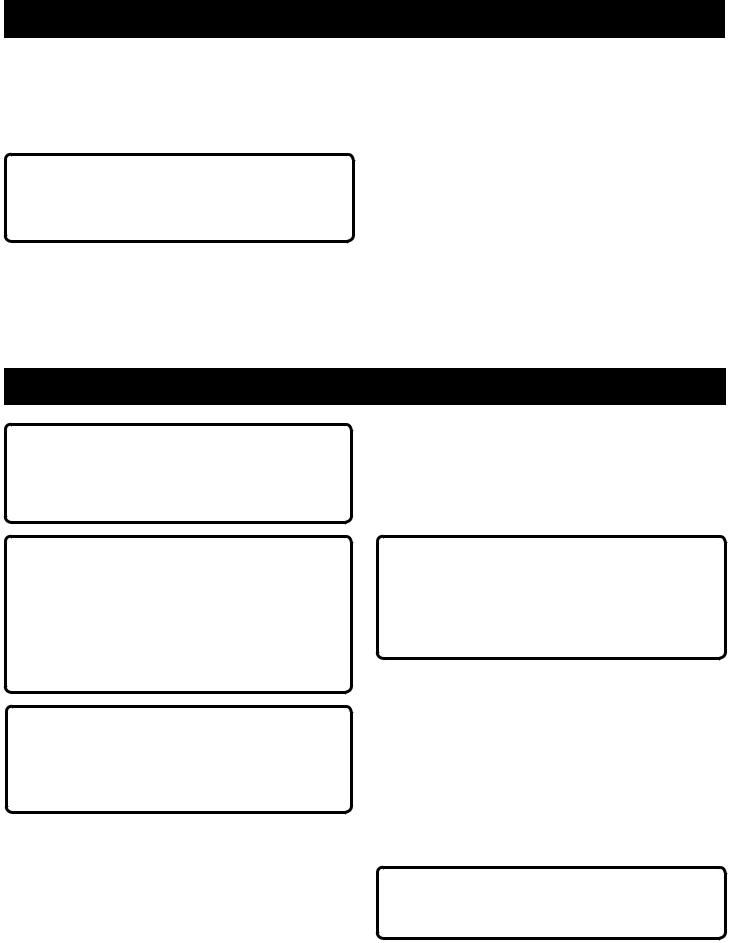
ASSEMBLY
NOTE: If the button does not release completely in the positioning hole, the shafts are not locked into place. Slightly rotate from side to side until the button is locked into place.
Tighten the knob securely.
 WARNING:
WARNING:
Be certain the knob is fully tightened before operating equipment; check it periodically for tightness during use to avoid serious personal injury.
ATTACHING THE FRONT HANDLE
See Figure 3.
Remove wing nut, washer, and bolt from the front handle.
Install the front handle onto the top side of the drive shaft housing in the area indicated by the label.
NOTE: The open side of the handle should face the operator.
Place the bolt through the front handle.
NOTE: The hex bolt head fits inside the hex recess molded into one side of the handle.
Reinstall the washer and wing nut.
Tighten wing nut securely.
REMOVING AN ATTACHMENT FROM THE POWER HEAD
For removing or changing the attachment:
Loosen the knob.
Push in the button and twist the shafts to unlock and separate.
OPERATION
 WARNING:
WARNING:
Do not allow familiarity with product to make you careless. Remember that a careless fraction of a second is sufficient to inflict serious injury.
Prior to replacing the fuel cap, clean and inspect the gasket.
Immediately replace fuel cap and hand tighten. Wipe up any fuel spillage.
NOTE: It is normal for smoke to be emitted from a new engine after first use.
 WARNING:
WARNING:
Always wear eye protection with side shields marked to comply with ANSI Z87.1, along with hearing protection. Head protection may also be required depending on the type of attachment used and as prescribed in the attachment’s Operator’s Manual. Failure to do so could result in objects being thrown into your eyes and other possible serious injuries.
 WARNING:
WARNING:
Do not use any attachments or accessories not recommended by the manufacturer of this product. The use of attachments or accessories not recommended can result in serious personal injury.
FUELING AND REFUELING THE TRIMMER
Clean surface around fuel cap to prevent contamination.
Loosen fuel cap slowly. Rest the cap on a clean surface.
Carefully pour fuel into the tank. Avoid spillage.
 WARNING:
WARNING:
Always shut off engine before fueling. Never add fuel to a machine with a running or hot engine. Move at least 30 ft. from refueling site before starting engine. Do not smoke! Failure to heed this warning could result in serious personal injury.
OXYGENATED FUELS
DO NOT USE E85 FUEL. IT WILL VOID YOUR WARRANTY.
NOTE: Fuel system damage or performance problems resulting from the use of an oxygenated fuel containing more than the percentages of oxygenates stated previously are not covered under warranty.
Ethanol. Gasoline containing up to 10% ethanol by volume (commonly referred to as E10) or 15% ethanol by volume (commonly referred to as E15) are acceptable.
Do not use E85 fuel.
CAUTION:
Attempting to start the engine before it has been properly filled with lubricant will result in equipment failure.
7 — English
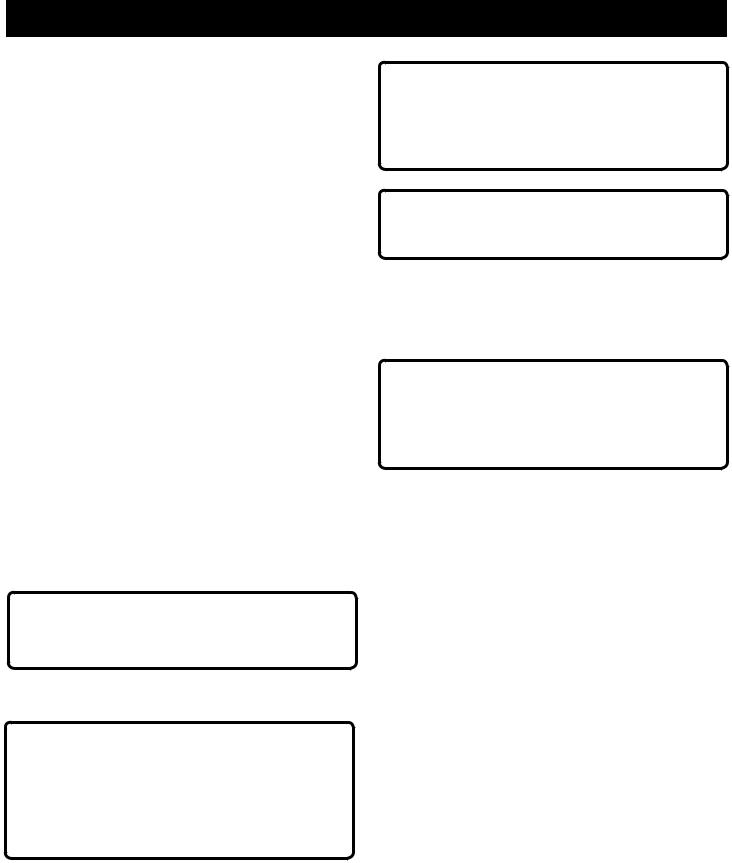
OPERATION
ADDING/CHECKING ENGINE LUBRICANT
See Figure 4.
Engine lubricant has a major influence on engine performance and service life. This unit is shipped with a 20W50 engine lubricant to assist in the break-in period. For best operating performance, continuing to use 20W50 engine lubricant is recommended, however, SAE 30, 10W30, or 10W40 are all acceptable lubricants to use in this product. Always use a 4-stroke motor lubricant that meets or exceeds the requirements for API service classification SJ. Check lubricant level before each use.
NOTE: Non-detergent or 4-stroke engine lubricants will damage the engine and should not be used.
To add engine lubricant:
Remove the cap and seal from lubricant bottle provided.
Unscrew the oil cap/dipstick and remove.
Using funnel provided, add entire bottle of engine lubricant through oil fill hole.
Reinstall the oil cap/dipstick and secure.
To check engine lubricant level:
Set unit on a flat surface.
Wipe dipstick clean and re-seat in hole; do not rethread.
Removedipstickagainandchecklubricantlevel.Lubricant level should fall within the hatched area on the dipstick.
If level is low, add engine lubricant until the fluid level rises to the upper portion of the hatched area on the dipstick.
Replace and secure the oil cap/dipstick.
 CAUTION:
CAUTION:
Do not overfill. Overfilling the crankcase may cause excessive smoke, oil loss, and engine damage.
OPERATING THE POWER HEAD
See Figure 5.
 WARNING:
WARNING:
Engine housing may become hot during trimmer operation. Do not rest or place your arm, hand, or any body part against the engine housing during trimmer operation. Only hold the trimmer as shown in Figure 5 with all body parts clear of engine housing. Extended contact with the engine housing may result in burns or other injuries.
 WARNING:
WARNING:
Always position the unit on the operator’s right side. The use of the unit on the operator’s left side will expose the user to hot surfaces and can result in possible burn injury.
 WARNING:
WARNING:
To avoid burns from hot surfaces, never operate unit with the bottom of the engine above waist level.
Hold the power head with your right hand on the rear handle and your left hand on the front handle. Keep a firm grip with both hands while in operation. Power head should be held at a comfortable position with the rear handle about hip height.
 WARNING:
WARNING:
Always hold the power head away from the body keeping clearance between the body and the product. Any contact with the attachment cutting head can result in burns and/or other serious personal injury.
STARTING AND STOPPING
See Figures 6 - 8.
To start a cold engine:
DO NOT squeeze the throttle trigger until the engine starts and runs.
Lay the trimmer on a flat, bare surface.
PRIME - Slowly press the primer bulb 10 times.
NOTE: After the 7th press, fuel should be visible in the primer bulb. If it is not, continue to press the primer until you see fuel in the bulb.
SET the start lever to the START position.
PULL the rope until the engine starts.
Squeeze the trigger to run.
NOTE: Squeeze the trigger lock out to engage the throttle trigger. Squeezing and releasing the throttle trigger releases the start lever to the RUN position.
To start a warm engine:
PULL the rope until the engine starts.
To stop the engine:
Press and hold the stop switch in the stop “  ” position until the engine stops.
” position until the engine stops.
8 — English
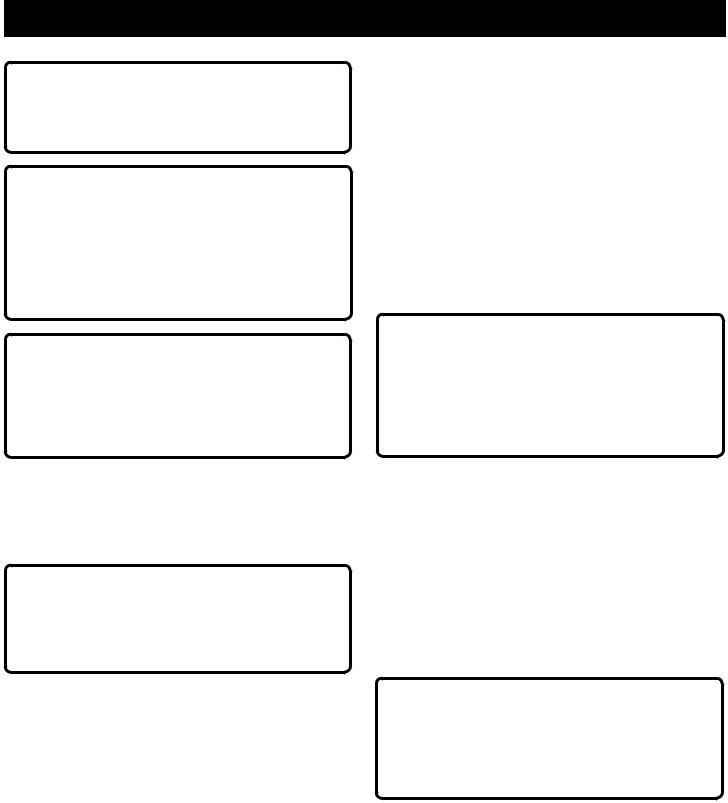
MAINTENANCE
 WARNING:
WARNING:
When servicing, use only identical replacement parts. Use of any other parts may create a hazard or cause product damage.
 WARNING:
WARNING:
Always wear eye protection with side shields marked to comply with ANSI Z87.1, along with hearing protection. Head protection may also be required depending on the type of attachment used and as prescribed in the attachment’s Operator’s Manual. Failure to do so could result in objects being thrown into your eyes and other possible serious injuries.
 WARNING:
WARNING:
Before inspecting, cleaning, or servicing the machine, shut off engine, wait for all moving parts to stop, and disconnect spark plug wire and move it away from spark plug. Failure to follow these instructions can result in serious personal injury or property damage.
SPARK ARRESTOR
The spark arrestor must be cleaned or replaced every 50 hours or yearly to ensure proper performance of your product. Spark arrestors may be in different locations depending on the model purchased. Please contact your nearest service dealer for the location of the spark arrestor for your model.
IDLE SPEED ADJUSTMENT
See Figure 9.
If the cutting attachment turns at idle, the idle speed screw needs adjusting on the engine. Turn the idle speed screw counterclockwise to reduce the idle RPM and stop the cutting attachment movement. If the cutting attachment still moves at idle speed, contact a service dealer for adjustment and discontinue use until the repair is made.
 WARNING:
WARNING:
The cutting attachment should never turn at idle. Turn the idle speed screw counterclockwise to reduce the idle RPM and stop the cutting attachment, or contact a service dealer for adjustment and discontinue use until the repair is made. Serious personal injury may result from the cutting attachment turning at idle.
GENERAL MAINTENANCE
Avoid using solvents when cleaning plastic parts. Most plastics are susceptible to damage from various types of commercial solvents and may be damaged by their use. Use clean cloths to remove dirt, dust, lubricant, grease, etc.
 WARNING:
WARNING:
Do not at any time let brake fluids, gasoline, petroleumbased products, penetrating lubricants, etc., come in contact with plastic parts. Chemicals can damage, weaken or destroy plastic which may result in serious personal injury.
You can often make adjustments and repairs described here. For other repairs, have the power head serviced by an authorized service dealer.
CLEANING THE EXHAUST PORT AND MUFFLER
NOTE: Depending on the type of fuel used, the type and amount of lubricant used, and/or your operating conditions, the exhaust port, muffler, and/or spark arrestor screen may become blocked with carbon deposits. If you notice a power loss with your gas powered tool, you may need to remove these deposits to restore performance. We highly recommend that only qualified service technicians perform this service.
CLEANING AIR FILTER SCREEN
See Figures 10 - 11.
For proper performance and long life, keep air filter screen clean.
Remove the air filter cover by pushing down on the latch with your thumb while gently pulling on the cover.
Brush the air filter screen lightly to clean.
Replace the air filter cover by inserting the tabs on the bottom of the cover into the slots on the air filter base; push the cover up until it latches securely in place.
FUEL CAP
 WARNING:
WARNING:
Check for fuel leaks. A leaking fuel cap is a fire hazard and must be replaced immediately. If you find any leaks, correct the problem before using the product. Failure to do so could result in a fire that could cause serious personal injury.
The fuel cap contains a non-serviceable filter and a check valve. A clogged fuel filter will cause poor engine performance. If performance improves when the fuel cap is loosened, check valve may be faulty or filter clogged. Replace fuel cap if required.
9 — English

MAINTENANCE
SPARK PLUG REPLACEMENT
This engine uses a Champion RY4C spark plug with .025 in. electrode gap. Use an exact replacement and replace annually.
CHANGING ENGINE LUBRICANT
See Figure 12.
For best performance, engine lubricant should be changed after every 25 hours of operation.
To change the engine lubricant:
Stop the engine and disconnect the spark plug wire. Allow the engine to cool completely before proceeding.
Remove the screw from the top engine cover and set aside.
Remove the screws from the bottom of the engine cover. Remove the bottom cover and set aside.
Remove the oil fill cap/dipstick.
Tip power head on its side and allow lubricant to drain from the oil fill hole into an approved container.
NOTE: Drain the lubricant while the engine is still warm but not hot. Warm lubricant will drain quickly and more completely.
Return the power head to an upright position and refill with lubricant following the instructions in the Adding/Checking Engine Lubricant section previously in this manual.
Reinstall the bottom engine cover. Replace the screws and tighten securely.
Replace the screw in the top engine cover and tighten securely.
NOTE: Used lubricant should be disposed of at an approved disposal site. See your local retailer for more information.
ADJUSTING CAMSHAFT-TO-ROCKER ARM CLEARANCE
See Figures 13 - 15.
Inspect the camshaft-to-rocker arm clearance after every 25 hours of operation. This should be done in a clean, dustfree environment.
NOTE: This procedure requires partial disassembly of the engine. If you are unsure if you are qualified to perform this operation, take the unit to an authorized service center.
Stop the engine and disconnect the spark plug wire. Allow the engine to cool completely before proceeding.
Remove the screw from the top engine cover. Remove engine cover and set aside.
Using a Torx screwdriver, remove the screw from the rocker arm cover. Remove the cover and set aside.
Position camshaft by pulling the recoil starter grip just until the deep hole in the camshaft gear is located at the 6 o’clock position as shown.
Place the feeler gauge under each rocker arm and measure the gap. The gap should be between .006 in. (0.15 mm) and
.008 in. (0.20 mm) for both rocker arms.
NOTE: Use a standard automotive feeler gauge. The .006 in. (0.15 mm) feeler gauge should slide between the rocker arm and valve stem with a slight amount of resistance but without binding. The 0.008 in. (0.20 mm) feeler gage should not slide between the rocker arms and the cam lobes — it should be held tight.
If the valve clearance is not between .006 in. (0.15 mm) and
.008 in. (0.20 mm), the clearance should be adjusted as follows:
•While holding a wrench on the flats of the adjusting nut with one hand, loosen the retaining nut with a second wrench as shown. Take care not to loosen the stud.
•Rotatetheadjustingnutuntilittouchesthefeelergauge.
Once the gap setting is correct, hold the wrench on the flats of the adjusting nut and retighten the retaining nut securely.
Adjust the second rocker arm, if necessary.
Replace the rocker arm cover and screw; tighten securely.
Replace the top engine cover and screw; tighten securely .
 WARNING:
WARNING:
Ensure all engine cover and all engine parts are completely and properly reassembled before starting engine. Failure to correctly reassemble engine may result in serious injury or property damage.
STORING THE PRODUCT
Clean all foreign material from the product. Store idle unit indoors in a dry, well-ventilated area that is inaccessible to children. Keep away from corrosive agents such as garden chemicals and de-icing salts.
Abide by all ISO and local regulations for the safe storage and handling of gasoline.
When storing 1 month or longer:
Drain all fuel from tank into a container approved for gasoline. Run engine until it stops.
HIGH ALTITUDE ENGINE OPERATION
Please have an authorized service center adjust this engine if it is to be run above 2000 feet. Failure to do so may result in poor engine performance, spark plug fouling, hard starting, and increased emissions. Carburetor adjustment by an authorized service center will improve performance and allow that this engine meets EPA (Environmental Protection Agency) and California ARB (Air Resources Board) emission standards. An engine adjusted for high altitudes can not be run at 2000 feet or lower. In doing so, the engine will overheat and cause serious engine damage. Please have an authorized service center restore high altitude modified engines to the original factory
specification before operating below 2000 feet.
10 — English

TROUBLESHOOTING
IF THESE SOLUTIONS DO NOT SOLVE THE PROBLEM CONTACT YOUR AUTHORIZED SERVICE DEALER.
PROBLEM |
POSSIBLE CAUSE |
SOLUTION |
Engine will not start |
No spark. |
Clean or replace spark plug. Reset |
|
|
spark plug gap. Refer to Spark Plug |
|
|
Replacement earlier in this manual. |
|
No fuel. |
Push primer bulb until bulb is full of |
|
|
fuel. If bulb does not fill, primary fuel |
|
|
delivery system is blocked. Contact an |
|
|
authorized service center. If primer bulb |
|
|
fills, engine may be flooded, proceed |
|
Engine is flooded. |
to next item. |
|
|
|
|
|
Set the start lever to the START position. |
|
|
Squeeze the trigger and pull the rope |
|
|
repeatedly until the engine starts and |
|
|
runs. |
|
|
NOTE: Depending on the severity of |
|
|
the flooding, this may require numerous |
|
|
pulls of the rope. |
|
|
|
Engine does not reach full speed and |
Air filter screen is dirty. |
Clean air filter screen. Refer to Clean- |
emits excessive smoke |
|
ing Air Filter Screen earlier in this |
|
|
manual. |
|
Spark arrestor screen is dirty. |
Contact an authorized service center. |
|
Spark plug fouled. |
Clean or replace spark plug. Reset |
|
|
spark plug gap. Refer to Spark Plug |
|
|
Replacement earlier in this manual. |
|
|
|
Engine starts, runs, and accelerates |
Idle speed screw on carburetor needs |
Turn idle speed screw clockwise to |
but will not idle |
adjustment. |
increase idle speed. See Figure 9. |
|
|
|
Engine emits too much smoke |
Too much oil in crankcase. |
Drain lubricant and refill with correct |
|
|
amount of 10W-30 engine lubricant. |
|
|
See Adding/Checking Engine |
|
|
Lubricant in the Operation section of |
|
|
this manual. |
|
|
|
Engine rope cannot be pulled |
Oil has entered the combustion |
This is usually caused by storing the unit |
|
chamber. |
for an extended time with the engine in |
|
|
an upside-down position. Remove and |
|
|
clean the spark plug. Drain the oil out |
|
|
of the spark plug hole, then reinstall the |
|
|
spark plug. |
|
|
|
11 — English
